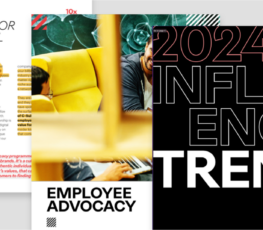Whether you currently have an employee advocacy program or are gearing up for one, this guide will be useful for you in either case.
At the heart of employee advocacy are your employees and their content. If you don’t have a content or social strategy in-place, employee advocacy will have a hard time being effective.
So before launching a tool like EveryoneSocial, make sure you are putting a content framework plan in place first. If you work with our team and product, we will be there every step of the way during your strategy, launch, as well as on-going business reviews and support!
Just to reiterate: content is hugely important for employee advocacy. And this doesn’t mean just creating company blog content for sharing. Blog content is certainly a necessary component, but advocacy and content strategy goes much deeper than that.
Why You Need A Content Strategy for Employee Advocacy
- Informing employees and sharing knowledge
- Create content that employees their network connections want engage with
- Helps you understand the types of content to funnel in
- Keeping the content organized and easy to maintain
- Helps you understand the impact on company goals and reasons for a program
87.2% surveyed recognized that employee advocacy contributed to expanding their professional network and 76% believed that it helped them keep up with industry trends. (Hinge Marketing)
Content Types Your Program Must Consider
There are many reasons for adopting employee advocacy, but your strategy needs might prioritize certain content types over others.
For example, if your use case is primarily for sales teams, then the content should be focused on various stages of the buyer’s journey, sales content for your team to learn from, social listening content, and sales collateral.
But if you are scaling employee advocacy to more departments or company-wide initiatives, having an array of content types organized in your program will yield higher employee engagement.
Your employee advocacy program will become the central hub for all employees to connect, engage, create, and share content. This has a profound effect on multiple areas of your company like marketing, sales, employer brand, recruiting, and strengthening internal communications and employee engagement. Plus, it starts to humanize your brand online!
Remember, your content in your program should always contain a mix of links, images, videos, and even plain text. And some content will be for internal use only.
Let’s dive into the various content types and their value toward your employee advocacy program.
- Company News: Content about your company and industry. This can be a mix of content for sharing publicly or for internal consumption only.
- Educational Content: This is content that helps audiences learn something or help with a pain point they might be having. Typically could be blog content that is top of the funnel that you’d want other employees to engage with and share to their networks.
- Employee Stories: People love reading about how companies are treating their employees and the diverse experiences their people bring. Content or videos about individual employees, accomplishments, cool things they are working on, etc.
- Content to Engage: This would be content from branded social channels or partners that you can include in your advocacy program. The content will include a button that will take employees right to the content to like, comment, or reshare. A great way to boost content in algorithms and drive more readership to branded account posts or to engage other employees’ social posts.
- Buyer Persona Content: Your sales and market teams will typically create content that is more mid or bottom of funnel and highly targeted. This content can also be engaging and useful for others to interact and share.
- User-Generated Content: A great way to be more authentic and get employees engaged is with user-generated content. That is letting them create some content, add content, and share. This gets your team more vested into a program and humanizes your brand. This can be images, videos, quick text, or even recommended content they find interesting.
- Internal Content for Engagement Only: Community building depends upon internal content: research, announcements, ideas, company wins, outside interests, etc. Whatever you see as valuable to connecting and engaging your teams can be done.
- Third-party content: And of course you cannot forget to include content that is from other sources. Maybe this is content from industry related publications, content that resonates with your brand, or other content you think people should read. As a general rule, content strategy is usually constituted by anywhere from two-thirds to four-fifths of third-party content.
Content Strategy Framework For Employee Advocacy
Now that you know the various types of content your employee advocacy program can potentially have, it’s time to build your framework. These steps are essential for your employee advocacy content framework.
Get organized
Setting up your employee advocacy program doesn’t have to be difficult, but if you aren’t organized it can be. Before diving in and getting employees activated, work on how you want your content to be organized.
Think about the content groups, what each group in your program will consist of and be used for, how you can organize your content sources, and what groups of employees will be involved in your program.
This information will help your advocacy vendor set up your instance easier and help you start off with a well-thought out social program.
It doesn’t have to be perfect from the start as you can always make changes.
Coordinate with program leads on goals
Depending on your program goals and overall employee advocacy priorities, you may be the only admin or perhaps one of many. Either way, you want to coordinate together as well with any department leads about the goals of your program.
This can be a mix of goals like very high-level and broader goals as well as very specific goals. For example:
- Get 250 employees active in our social program
- Increase brand awareness via our employee advocates
- Increase branded web traffic by 15% in our first quarter
You’ll certainly have additional campaign specific goals with your advocacy program, but having some initial goals will help you understand your content needs.
Write Down Your Needed Content Types
As mentioned earlier in this post, you want to create and organize the right mix of content that stays fresh and engaging for your employees. There are many variations to choose from, but not all may fit your employee advocacy needs and priorities.
In order to identify what content types you may need in your program, you can do a few things:
- Survey employees about their content consumption and engagement
- What your campaigns are and how your goals are enabled by employee advocacy
- Monitor how your external audiences consume content types
Additionally, third party content is always a smart move to have in your program. This is a good time to also identify the different sources of content you can use in your employee advocacy program.
What media publications do you value? What keywords or hashtags of content might you want to pull into your program? All of these can be added into specific and organized groups for people to have access to and share. Or you can make some posts read only.
Segmentation and Streams
When it comes to your content framework in employee advocacy, understanding your segmentation and content streams will be important. Using simple layouts and understanding how your people will interact can greatly improve employee engagement.
You’ll want to segment your content and employees, so they have visibility on the content that is most relevant to them at all times.
You can segment your employees based on department, role, and location — that way you can ensure current and future content will resonate more effectively in each segmentation.
For example, everyone might have access to company announcements in your program. But you might have individual channels that are only for various groups of people.
You can create a “sales” content group, which is content and information related to and for your organization’s sales department. You can invite all the sales leaders to this group.
And this way, departments such as customer service or human resources folks don’t get distracted by content that is not interesting or relevant to them.
There is no single canonical method of how you group employees and your content, but segmentation can help remove noise and keep content organized and tailored to your platform users.
Build a policy that encourages employees to create
Part of a good content strategy for employee advocacy is also to have a policy in place for employees to easily have accessible. Generally, this will be a social media policy blended with your content strategy.
This is important because a large part of what makes a great employee advocacy program is letting employees submit content, create, and of course share to their networks.
But your organization still needs to have some boundaries in place and information that helps your people know things like:
- Why your company is pursuing this strategy
- How employees can contribute to success
- The benefits to them when they get involved in the program
- What is okay and not okay to create, post or share during company time
- Tips and tactics to help the grow professionally through content and social media
Track and monitor results
In your employee advocacy platform, you’ll have the ability to track and measure results from content and shares. You’ll have external metrics and internal metrics too based on your team within your platform.
Pay close attention to this information, as it can help guide your content for both internal and external consumption. It can signal what is most engaging and interesting to your employees.
And it can show you what content that the networks of your employees are finding most interesting and engaging too.
All of this monitoring helps your organization create more content and social sharing campaigns around what is working to drive better engagement and attention toward your brand. It also helps you identify which social channels are working best and what content is connecting with audiences.
The observations you make in your program and the data can constitute a roadmap for navigating achievable goals like: getting users to sign in more, increasing the content they share and engage with, etc. And it helps give your program a tune-up to help you generate strong ROI.
Compliance and Regulating Content
Something that has to be discussed is if you work in an industry or company that requires compliance on content. With employee advocacy platforms like EveryoneSocial, you can append hashtags or phrases to any future shares from employees.
Content that should only be for internal consumption can easily be locked down, to ensure no employee accidentally shares sensitive company information.
Additionally, admins or moderators in the program can provide suggested copy to go with the social shares, which employees can utilize or alter. You can also lockdown custom commentary, however we highly recommend not doing this on all content.
The goal of employee advocacy is to let employees be authentic and share their thoughts. Audiences can sense automated social copy and your brand starts to look like a group of spammers.
Any hesitation about rolling out employee advocacy typically revolves around the question “What if someone shares something negative about us?”
In all the years working with many companies, we’ve never seen this happen.
If current employees know your social policy, enjoy the work and company — then you have a team willing to advocate for you. As industry leaders, our clients are exemplary in hiring trustworthy employees, something we imagine most companies aspire for.
Additionally, because employees can suggest content links too, your team can still ensure an approval process to guarantee that content is vetted before going to streams for engagement and sharing.
Final Thoughts
This might be a lot to think about as a program admin or leader. But it’s not as overwhelming as you might think when working with the right support team.
At EveryoneSocial, we’ve built a product and team that can help you navigate these decisions and content organization much easier starting from pre-launch to years into your program.
We are only successful when your team and company are, so we provide as much training and support as needed.
The beauty of it all is once you have your strategy and framework set up, admin management takes only a few minutes a day. Not bad for how much impact your content and employee advocacy can have on your entire organization, right?
















